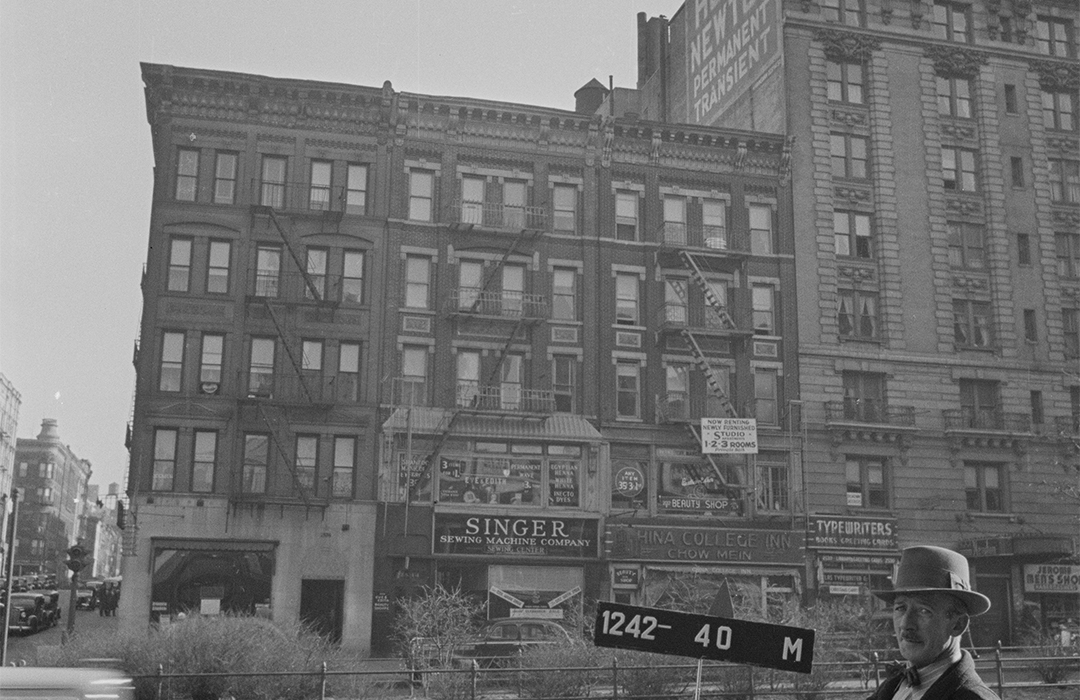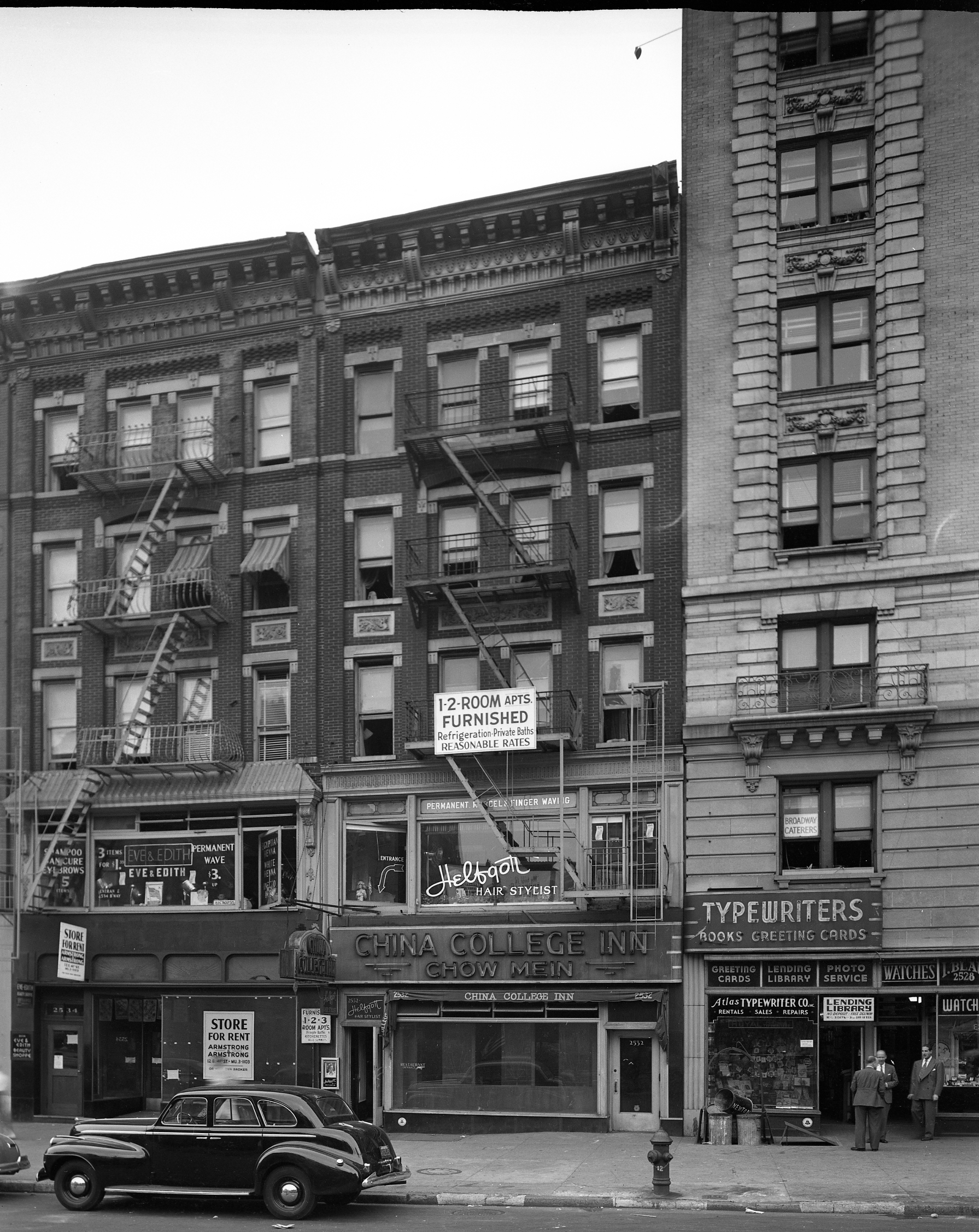
The Bonneyview and Ordway
by Tom Miller
In October 1887, architect C. Baxter simultaneously filed plans for two projects for developers Thos. Wren & Co—a “five story brick tenement and store” at the southeast corner of the Boulevard (later Broadway) and West 95th Street, and two narrower, five-story tenements with stores next door. (The term “tenement” at the time referred to any multi-family structure.) The matching pair would be named the Bonnyview, at what would become 2532 Broadway, and the Ordway at 2534.
Completed in 1888, the identical buildings were faced in red brick and trimmed in stone. Baxter splashed his overall Renaissance Revival design with elements of Queen Anne (seen, for instance, in the stepped brick corbels above the top floors) and neo-Grec (in the bold stone lintels and incised carvings).
Although they were termed “bachelor apartments” because they did not have kitchens, by the turn of the century, professional, unmarried women occupied some of the suites. Living at 2532 Broadway in 1901, for instance, was Miss A. B. Orton. Interestingly, she occupied her apartment only during the summer months. During the winters, she was the principal of the English Classical School for Girls in Pasadena, California. Another unmarried educator in the Bonnyview was Helen S. Fletcher, a teacher in the Girls’ Department of Public School 87 on Amsterdam Avenue at 77th Street.
Although they were termed “bachelor apartments” because they did not have kitchens, by the turn of the century, professional, unmarried women occupied some of the suites.
Following the death of his wife, Mary Anderson Canfield, in 1903, Charles Bolles Canfield shared an apartment in the Bonnyview with his son, Charles William Canfield. Born in Hartford, Connecticut, in 1830, he moved to New York with his wife in 1886 and established the New England Monument Company. One of the best-known monument builders in the country, he was responsible for the grave of President Chester A. Arthur near Albany and for the 1897 Grant’s Tomb on Riverside Drive. A life-long bachelor, Charles William was an 1878 graduate of Yale University and was associated with his father in the New England Monument Company. Charles Bolles Canfield died at the age of 78 in their apartment on June 17, 1908.
The variety of occupations of the buildings’ residents was remarkable. In 1904, Eva Cohen told a courtroom, “My business is hairdresser and professional massage,” and in 1910, Harvey F. Hancock, who lived in the Ordway, testified, “My business is searcher for judgments of the Title Insurance Company.”
In 1919, architect Samuel Cohen filed plans to renovate the two lower floors of 2532 Broadway into a restaurant. Called Pomerantz’s, the private dining room upstairs was the scene of testimonial dinners and political events. On October 25, 1924, The Sun reported on the busy day of Theodore Roosevelt, who was running for governor. The article noted, “The Colonel will wind up the night at 11 o’clock by a speech in Pomerantz’s Restaurant, 2532 Broadway.”
Following the death of his wife, Mary Anderson Canfield, in 1903, Charles Bolles Canfield shared an apartment in the Bonnyview with his son, Charles William Canfield. Born in Hartford, Connecticut, in 1830, he moved to New York with his wife in 1886 and established the New England Monument Company. One of the best-known monument builders in the country, he was responsible for the grave of President Chester A. Arthur near Albany and for the 1897 Grant’s Tomb on Riverside Drive. A life-long bachelor, Charles William was an 1878 graduate of Yale University and was associated with his father in the New England Monument Company. Charles Bolles Canfield died at the age of 78 in their apartment on June 17, 1908.
The variety of occupations of the buildings’ residents was remarkable. In 1904, Eva Cohen told a courtroom, “My business is hairdresser and professional massage,” and in 1910, Harvey F. Hancock, who lived in the Ordway, testified, “My business is searcher for judgments of the Title Insurance Company.”
In 1919, architect Samuel Cohen filed plans to renovate the two lower floors of 2532 Broadway into a restaurant. Called Pomerantz’s, the private dining room upstairs was the scene of testimonial dinners and political events. On October 25, 1924, The Sun reported on the busy day of Theodore Roosevelt, who was running for governor. The article noted, “The Colonel will wind up the night at 11 o’clock by a speech in Pomerantz’s Restaurant, 2532 Broadway.”
The building’s super, Alfonse de Coursey, was charged with “maintaining a disorderly house,” the polite term for a brothel.
In the meantime, 2534 Broadway had undergone a similar renovation. In 1918, Dr. Chester T. Hustis’s dental office was on the second floor and Asia Restaurant occupied the first. The remodeling had downsized the apartments as well. Potential tenants could now choose among apartments of one, two or three rooms.
The Ordway received unwanted publicity on March 2, 1922 when the New-York Tribune reported, “Three detectives of the vice squad conducted a raid at 2534 Broadway, near Ninety-fifth Street, yesterday, and arrested nine persons. Seven women were charged with vagrancy.” The building’s super, Alfonse de Coursey, was charged with “maintaining a disorderly house,” the polite term for a brothel.
Joseph Teitelbaum, who ran the beauty parlor at 2534, would have to move by 1941, when the ground floor tenant, the Singer Sewing Machine Co. expanded upward. Retail stores recognized that employees might occasionally pilfer an item, but Singer Sewing Machine Co. dealt with a larger theft in 1939. On June 9, 37-year-old Pierre Contresty was arrested and charged with having stolen a $91.80 sewing machine from the store. His boss, Herman Webber, accused him of taking the machine “while employed by the company.”
At the time of the brazen theft, the first and second floors of 2532 Broadway were home to the China College Inn, an Asian restaurant. The newly renovated apartments were advertised in 1938 as having “2-1/2 rooms, refrigeration, kitchenettes, private baths.”
The tradition of a ground floor restaurant continued at 2532 in 1968 with La Victoria-China, described by New York magazine in March 1970 as an “inexpensive ethnic restaurant.” Next door, a Thai restaurant, Lemongrass Grill, opened in 1999 and remained at least through 2008. Today the Manhattan Diner occupies the ground floor of 2532, and a Popeyes Chicken franchise operates next door.
Tom Miller is a social historian and blogger at daytoninmanhattan.blogspot.com
BUILDING DATABASE
Keep Exploring
Be a part of history!
Think Local First to support the businesses at 2532-2534 Broadway:



